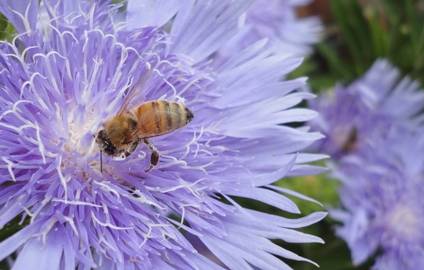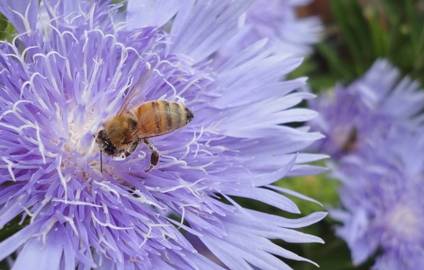 It is national pollinator week, and the University of Illinois is celebrating with some fantastic events this weekend! To get in the spirit, let’s talk about pollination.
It is national pollinator week, and the University of Illinois is celebrating with some fantastic events this weekend! To get in the spirit, let’s talk about pollination.
Pollination is how plants reproduce, and since many delicious plant-derived foods result from fertilized ovaries, this is important to us as well. That yellow pollen that makes you sneeze and covers your car (or bike, or walking shoes) in the spring and summer is equivalent to millions of sperm cells, looking for female plant parts. More ancient plants, such as mosses and ferns, still have flagella on their spores, which is why they have to live in moist areas: Their “sperm” still needs to swim. But not higher plants! Pollen represents an evolutionary innovation that allows plants to thrive on land and spread their genes far and wide.
However, plants are not mobile. They can’t saunter off to meet another plant and hook up at a plant party. So they rely on other methods to spread pollen to female flowers or cones. Many species use the wind to spread their pollen, but you can imagine it might be more beneficial to have some insurance that your pollen will reach another plant of your species, especially if you are spread widely throughout an environment.
Here is where wonderful pollinators come in! We are all used to the familiar examples of bees, butterflies, and birds (think hummingbirds) as examples of pollinators. But were you aware of other pollinators such as:
Bats – Bats are important pollinators throughout the world (although all of the bats here in central Illinois eat insects). Species of bats that drink nectar tend to have very long tongues to allow them to drink nectar hiding at the bottom of flowers. In order to get all the way down there, though, they have to press their face to the flower, getting a faceful of pollen in the process. They repeat this at the next flower, transferring the pollen along.
 Lizards – On the island of Mauritius, the usual pollinators (insects and birds) are too small or rare to successfully pollinate large plants. Researchers found that the blue-tailed day gecko fills this role by living on nectar from the plants, where it must crawl inside the flower to obtain its food.
Lizards – On the island of Mauritius, the usual pollinators (insects and birds) are too small or rare to successfully pollinate large plants. Researchers found that the blue-tailed day gecko fills this role by living on nectar from the plants, where it must crawl inside the flower to obtain its food.
Possums – Okay, so this one isn’t technically a possum. The honey possum is not a true possum, but a mouse-sized marsupial found in Western Australia. Its long snout resembles an anteater’s with reduced teeth and a long tongue, allowing it to drink nectar, which is its sole source of food (pretty strange for a mammal!)
But plants don’t just sit around, twiddling their leaves and waiting for pollinators to happen along. They attract pollinators in a variety of ways. In fact, the flower color, shape, and smell can all provide clues as to what pollinators the plant primarily relies on. This table is a good reference, but in general, things that smell good and are purple or blue are generally pollinated by insects, while things that don’t have a scent and are red or orange are generally pollinated by birds. Plants that are pollinated by moths or bats tend to be white and/or bloom at night, making them pop in the dark. Nectar itself is a bribe to manipulate animals for the plant’s personal gain. Plants also have some unusual tricks up their sleeves, such as:
Pretending to be a dead body – Some plants are pollinated primarily by flies. What do flies like? Dead and rotting things. The corpse flower (which bloomed here at the Plant Biology Greenhouse a couple of years ago) is fly pollinated, and smells like rotting meat. The skunk cabbage, a central Illinois native, is so-called for its foul stench, which flies just love.
Pretending to be a sexy lady – What’s a good way to attract male pollinators to your flowers? Pretend to be a good-looking lady, of course! Hammerhead orchids not only look like female wasps, but also emit a female wasp pheromone. When the male comes over and tries to mate with the decoy, the flower slaps him on the head with a whack of pollen. There is a great video of this here.
Singing to your pollinators – Bats use echolocation to hone in on things in their environment. Bats often are thought of as using echolocation to finely target erratically flying insects in the dark. However, it turns out that a bat-pollinated vine takes advantage of the bat’s echolocation to help guide the pollinators to its flowers. These vines have built-in “sonar dishes,” which bounce the bat’s echolocation back to them, providing an auditory road map to the delicious nectar and bountiful pollen.








